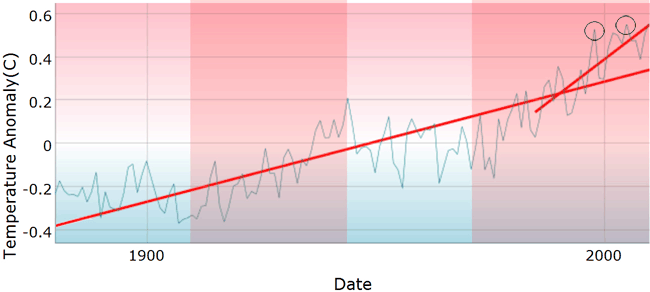Scientists' Explanation
Temperature Change Since the Industrial Revolution
If you look at temperature over short time scales of less than 10 years or so, you will observe both warming and cooling trends. Natural variability dominates the short time scale trends. One example of natural variability is the brief cold period in January and February of 2008. Over longer-time scales of decades, there is less variability.

Over the past hundred years, temperatures increased by 0.7°C. However, this increase in temperature is not linear. Two periods of warmer temperature are shown in the data over the past 125 years. First, temperature increased from the 1910s to the 1940s, and then temperature increased more rapidly from the 1970s to the present. In the next module, you will learn more about probable reasons for these trends. Some scientists think that aerosol pollution may have caused the cooling effect shown in the temperature anomaly data between the 1940s and 1970s. Aerosols scatter visible light from the sun, thus cooling the earth. In the early 1970s, aerosol pollution decreased because of the sulfur filters placed on power station smoke stacks, and temperatures began to rise.
Surface temperatures were highest in 1998 and 2005. The unusually warm 1998 surface temperatures were attributed to the 1997-1998 El Niño. The average global land and ocean temperature of 2010 tied with that of 2005 as the warmest period in a 131-year historical record, and the 2001-2010 decade was the warmest on record (Climate Prediction Center, NOAA, http://www.ncdc.noaa.gov/oa/ncdc.html).
To summarize, the data shows that the warming trend has actually accelerated over time, from 0.06°C per decade for the past 125 years to 0.22°C per decade for the past 25 years.
You have learned in this investigation and the previous one that global mean temperature (GMT) can increase quickly on a multi-decadal to a century time scale. The United States Climate Change Science Program defines “abrupt climate change” as a change in climate that takes place over a few decades or less, persists for a few decades, and causes substantial disruptions in human and natural systems. The Greenland ice core reveals abrupt changes in climate 50,000 to 10,000 years ago, so scientists know that climate can change over a short time scale. You observed a similar rate of temperature change over the past 25 years. A warming of almost 1°C over the last century may seem small, but 4°C is approximate difference between a glacial and interglacial climate.
